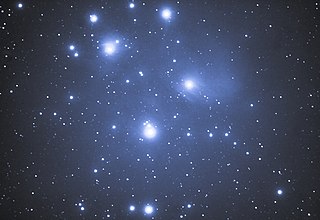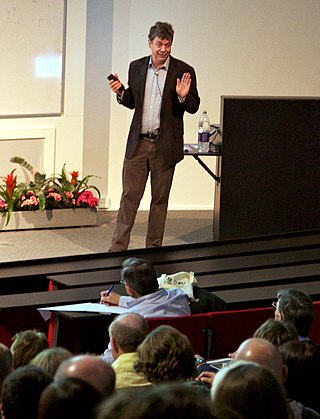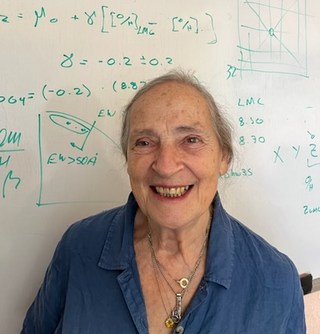Related Research Articles

A globular cluster is a spheroidal conglomeration of stars that is bound together by gravity, with a higher concentration of stars towards its center. It can contain anywhere from tens of thousands to many millions of member stars, all orbiting in a stable, compact formation. Globular clusters are similar in form to dwarf spheroidal galaxies, and the distinction between the two is not always clear. Their name is derived from Latin globulus. Globular clusters are occasionally known simply as "globulars".

An open cluster is a type of star cluster made of tens to a few thousand stars that were formed from the same giant molecular cloud and have roughly the same age. More than 1,100 open clusters have been discovered within the Milky Way galaxy, and many more are thought to exist. Each one is loosely bound by mutual gravitational attraction and becomes disrupted by close encounters with other clusters and clouds of gas as they orbit the Galactic Center. This can result in a loss of cluster members through internal close encounters and a dispersion into the main body of the galaxy. Open clusters generally survive for a few hundred million years, with the most massive ones surviving for a few billion years. In contrast, the more massive globular clusters of stars exert a stronger gravitational attraction on their members, and can survive for longer. Open clusters have been found only in spiral and irregular galaxies, in which active star formation is occurring.

Galactic astronomy is the study of the Milky Way galaxy and all its contents. This is in contrast to extragalactic astronomy, which is the study of everything outside our galaxy, including all other galaxies.

In astronomy, a galactic bulge is a tightly packed group of stars within a larger star formation. The term almost exclusively refers to the central group of stars found in most spiral galaxies. Bulges were historically thought to be elliptical galaxies that happened to have a disk of stars around them, but high-resolution images using the Hubble Space Telescope have revealed that many bulges lie at the heart of a spiral galaxy. It is now thought that there are at least two types of bulges: bulges that are like ellipticals and bulges that are like spiral galaxies.

Donald Lynden-Bell CBE FRS was a British theoretical astrophysicist. He was the first to determine that galaxies contain supermassive black holes at their centres, and that such black holes power quasars. Lynden-Bell was President of the Royal Astronomical Society (1985–1987) and received numerous awards for his work, including the inaugural Kavli Prize for Astrophysics. He worked at the University of Cambridge for his entire career, where he was the first director of its Institute of Astronomy.

The following outline is provided as an overview of and topical guide to astronomy:

NGC 3201 is a low galactic latitude globular cluster in the southern constellation of Vela. It has a very low central concentration of stars. This cluster was discovered by James Dunlop on May 28, 1826 and listed in his 1827 catalogue. He described it as "a pretty large pretty bright round nebula, 4′ or 5′ diameter, very gradually condensed towards the centre, easily resolved into stars; the figure is rather irregular, and the stars are considerably scattered on the south".
The Brouwer Award is awarded annually by the Division on Dynamical Astronomy of the American Astronomical Society for outstanding lifetime achievement in the field of dynamical astronomy. The prize is named for Dirk Brouwer.

Simon David Manton White, FRS, is a British-German astrophysicist. He was one of directors at the Max Planck Institute for Astrophysics before his retirement in late 2019.
Rainer Spurzem is a German astronomer at the Astronomisches Rechen-Institut in Heidelberg, Germany. His speciality is the N-body simulation of galaxies and star clusters.

Computational astrophysics refers to the methods and computing tools developed and used in astrophysics research. Like computational chemistry or computational physics, it is both a specific branch of theoretical astrophysics and an interdisciplinary field relying on computer science, mathematics, and wider physics. Computational astrophysics is most often studied through an applied mathematics or astrophysics programme at PhD level.
Douglas N. C. Lin is professor of astronomy and astrophysics at the University of California, Santa Cruz. He was born in New York and grew up in Beijing. He earned his BSc from McGill University, his PhD from the Institute of Astronomy, Cambridge University, and performed postdoctoral research at both Harvard and Cambridge. In 1979 he took an Assistant Professorship at UCSC, and has remained there since. He is also the founding director of the Kavli Institute for Astronomy and Astrophysics at Peking University.
Annapurni Subramaniam is the director of the Indian Institute of Astrophysics, Bangalore and works on areas like star clusters, stellar evolution and population in galaxies and Magellanic clouds.

NGC 6388 is a globular cluster of stars located in the southern constellation of Scorpius. The cluster was discovered by Scottish astronomer James Dunlop on May 13, 1826 using a 20 cm (9 in) reflector telescope. It was later determined to be a globular cluster by English astronomer John Herschel, who was able to resolve it into individual stars. NGC 6388 is located at a distance of approximately 35,600 light-years (10.90 kpc) from the Sun. Due to its apparent visual magnitude of +6.8, binoculars or a small telescope are required to view it.

A nuclear star cluster (NSC) or compact stellar nucleus is a star cluster with high density and high luminosity near the center of mass of most galaxies.
Douglas Cameron Heggie is a Scottish applied mathematician and astronomer, formerly holding the Personal Chair of Mathematical Astronomy at the School of Mathematics at the University of Edinburgh. His main research interests are in stellar dynamics.
Robert Michael Rich is an American astrophysicist. He obtained his B.A. at Pomona College in 1979 and earned his Ph.D. from the California Institute of Technology in 1986 under thesis supervisor Jeremy Mould. He was a Carnegie Fellow at Carnegie/DTM until 1988, when he became an assistant professor of astronomy at Columbia University; during this period, he was the doctoral advisor to Neil deGrasse Tyson. After two years (1996-1998) as a senior research scientist at Columbia, he joined the University of California, Los Angeles as a research astronomer in 1998. As of 2024, he remains affiliated with UCLA as a researcher emeritus/adjunct professor emeritus of astronomy and astrophysics.
In cosmology, Gurzadyan-Savvidy (GS) relaxation is a theory developed by Vahe Gurzadyan and George Savvidy to explain the relaxation over time of the dynamics of N-body gravitating systems such as star clusters and galaxies. Stellar systems observed in the Universe – globular clusters and elliptical galaxies – reveal their relaxed state reflected in the high degree of regularity of some of their physical characteristics such as surface luminosity, velocity dispersion, geometric shapes, etc. The basic mechanism of relaxation of stellar systems has been considered the 2-body encounters, to lead to the observed fine-grained equilibrium. The coarse-grained phase of evolution of gravitating systems is described by violent relaxation developed by Donald Lynden-Bell. The 2-body mechanism of relaxation is known in plasma physics. The difficulties with description of collective effects in N-body gravitating systems arise due to the long-range character of gravitational interaction, as distinct of plasma where due to two different signs of charges the Debye screening takes place. The 2-body relaxation mechanism e.g. for elliptical galaxies predicts around years i.e. time scales exceeding the age of the Universe. The problem of relaxation and evolution of stellar systems and the role of collective effects are studied by various techniques, see. Among the efficient methods of study of N-body gravitating systems are the numerical simulations, particularly, Sverre Aarseth's N-body codes are widely used.

Elena Kirilovsky-Terlevich is an Argentine astrophysicist who works in Mexico as a researcher in the National Institute of Astrophysics, Optics and Electronics (INAOE). Her research involves galaxy formation and evolution, and the patterns of star formation within galaxies, especially those with active nuclei.

Luigi Rolly Bedin, is an Italian astrophysicist and researcher at the National Institute of Astrophysics of the Padua Astronomical Observatory. His research focuses on stellar populations in open and globular clusters, exoplanets and nearby brown dwarfs. He is the discoverer with his team of the dwarf spheroidal galaxy Bedin I. He is a member of the International Astronomical Union.
References
- ↑ Aarseth, A. J. (2012). "Mergers and ejections of black holes in globular clusters". Monthly Notices of the Royal Astronomical Society . 422 (1): 841–848. arXiv: 1202.4688 . Bibcode:2012MNRAS.422..841A. doi: 10.1111/j.1365-2966.2012.20666.x . S2CID 62826586.
- ↑ Institute for Advanced Study: A Community of Scholars
- ↑ "List of Brouwer Award Winners". American Astronomical Society . Retrieved 27 June 2012.
- ↑ "Sverre's Interests". Institute of Astronomy, Cambridge. Retrieved 27 June 2012.
- ↑ "International Correspondence Chess Federation International Masters" (PDF). International Correspondence Chess Federation. November 2011. Archived from the original (PDF) on 6 March 2021. Retrieved 27 June 2012.